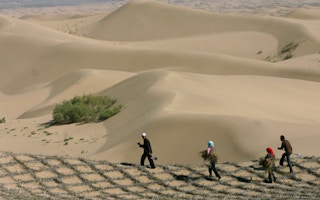The United Nations Convention to Combat Desertification (UNCCD) has praised China’s ongoing media campaign to raise awareness about successes in combating desertification, saying it “inspires hope.”
The campaign, named “Green Ribbon of the Earth,” was led by China’s Xinhua News Agency in cooperation with the State Forestry Administration (SFA). It highlighted the achievements and experience gained during a 35-year national forestation project to combat land desertification in northwest, north and northeast China.
“It shows that reversing desertification is possible not just at landscapes or ecosystem level but at continental-level. It inspires hope by showing that desertification is not a fate,” UNCCD Executive Secretary Luc Gnacadja said in a statement recently.
“Hope that land restoration is achievable. And hope that a land-degradation neutral world is possible because deforestation can be avoided, and where unavoidable, degraded land can be restored at a rate equal to or faster than its degradation,” Gnacadja added.
Launched in 1978, China’s Three-North Shelterbelt Forest Program, was expected to be completed by 2050 and cover about 4.07 million square km, accounting for 42.4 percent of the total land area of China.
The program aims to increase the forest area in the program regions by 35.083 million hectares, increase forest coverage from 5.05 percent in 1977 to 14.95 percent, effectively control sand storms and soil erosion, basically improve ecological conditions and primarily improve the living conditions of farmers.
Latest SFA data showed the forest coverage in the treated areas had increased to 12.4 percent at the end of 2012.
“The ‘Green Ribbon of the Earth’ campaign shows that with political will, this generation has the resources, technologies and knowledge to eliminate these challenges once and for all. Targeting the most vulnerable populations would ensure no one is left behind,” the UN official said.
In its two-month campaign, Xinhua sent reporters to 13 province-level regions involved in the project. A total of 41 other local print and online media organizations have joined the reporting.
“Xinhua News Agency is one of the few global media that has made and shown commitment to use its resources to raise awareness about desertification in a sustained manner globally, not just in China,” Gnacadja said.
In his statement, Gnacadja called for global action to fight desertification and drought: “It is a fight against poverty, against food and water insecurity, against child mortality, against ecosystem degradation and biodiversity loss.”
“Drylands account for 44 percent of all cultivated systems and half of the world’s livestock. We ignore their degradation at our peril. It is time to speak out and take action for change that will guarantee good global land stewardship and benefit for all,” Gnacadja said.
According to the Bonn-based UN body, every year about 12 million hectares of productive drylands become infertile due to desertification and drought.
More than two billion people live in drylands where desertification and drought are enduring challenges. About 90 percent of them are in developing countries, mostly in rural areas where land is their primary source of livelihood.
Globally, the largest population affected by desertification is in Asia, with more than 400 million of them in China alone.










